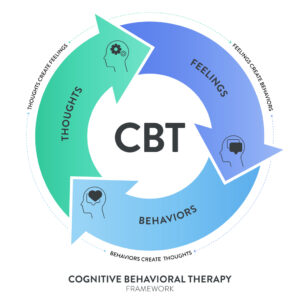
Image Credit: fauxels, Pexels.com Help for social anxiety near me. Help for social anxiety. Here, you will find the social anxiety quiz.
Key Points
Social anxiety disorder is more than shyness. It affects about 7% of adults in the U.S., often starting in adolescence, and can significantly limit careers, relationships, and quality of life if untreated.
Effective treatments are available. Medications like SSRIs and SNRIs help most people, while MAOIs, though rarely used, remain the “gold standard” in terms of potency. Many doctors feel the MAOIs are underused and that they are very effetive treatments. Combining medication with therapy often works best.
Cognitive-behavioral therapy (CBT) is highly effective. CBT teaches people to identify and challenge anxious thoughts, practice mindfulness, and gradually face feared situations through structured exposure and skills training. About 70–80% of people improve with CBT.
With help, recovery is possible. Many people with social anxiety go decades without a diagnosis, but treatment can open doors to new opportunities, stronger relationships, and greater confidence. Relief is within reach.
Case

Image Credit: fauxels, Pexels.com Help for social anxiety near me. Help for social anxiety. Here, you will find the social anxiety quiz.
Social anxiety disorder is more than shyness. It affects about 7% of adults in the U.S., often starting in adolescence, and can significantly limit careers, relationships, and quality of life if untreated.
Effective treatments are available. Medications like SSRIs and SNRIs help most people, while MAOIs, though rarely used, remain the “gold standard” in terms of potency. Many doctors feel the MAOIs are underused and that they are very effetive treatments. Combining medication with therapy often works best.
Cognitive-behavioral therapy (CBT) is highly effective. CBT teaches people to identify and challenge anxious thoughts, practice mindfulness, and gradually face feared situations through structured exposure and skills training. About 70–80% of people improve with CBT.
With help, recovery is possible. Many people with social anxiety go decades without a diagnosis, but treatment can open doors to new opportunities, stronger relationships, and greater confidence. Relief is within reach.
Several years ago, Carol* contacted me about the social anxiety worry and bouts of sadness that she had been experiencing for most of her life. When we met, she was in her late 30’s, single, and working in the education system. She thought she was just shy. She didn’t realize that having so much worry about social situations was so much more than being introverted.
For Carol, coping just meant she “learned to live with it.” Her anxiety affected several areas of her life, but it was most disruptive in social interactions. Though she had always been shy, around the age of 11 or 12, she began experiencing significant social worry. When she was around people, she became very sweaty, self-conscious, and worried about embarrassing herself. She avoided asking questions in class or asking for help. Over the years, her social life became more and more limited. Carol kept a few friends but struggled with making new friends. She made excuses to avoid parties or gatherings. Her anxiety affected her self-esteem and grades at school.
Even throughout college, her social worry continued to haunt her. As a result, Carol’s career options were severely limited. She found a job within the school system where there was minimal social interaction.
Her primary care doctor had known about Carol’s struggles for many years but didn’t know the source of her anxiety. At the doctor’s urging, Carol finally decided she needed to try seeking help.
Introduction
I decided to write about social anxiety disorder because many people struggle with the challenges and consequences for decades before they are ever diagnosed or treated. The goal was to create a comprehensive guide on social anxiety disorder that would provide as much information as possible as well as resources that would provide even more information.
Over 7.1 percent of the population in the United States have social anxiety. And, so many people who have it often think they are the problem or the only one with this issue. Or, that something is wrong with them. By writing and getting the word out about social anxiety disorder to the public as well as health care providers and doctors, I am hoping that more people have a better understanding of this disorder.
What is social anxiety disorder?
- According to the DSM V, social anxiety disorder is characterized by chronic, persistent fear or anxiety in the face of social situations in which the individual might get judged by others.
- Also known as SAD, social anxiety disorder usually presents during adolescence
How do I know if I have social anxiety disorder?
Here are some common ways people with SAD might describe themselves:
- “I’m afraid of embarrassing myself if I try to chat with others.”
- “The interviewer will think I’m too dumb for this job.”
- “I shouldn’t go to this party; they’ll all think I’m lame.”
- “I could call customer service… but I’d get humiliated on the phone.”
- “I’ll go home right after class so that I don’t have to see anyone I know.”
- “If I have to talk in front of people, my heart starts racing and my palms start sweating.”
Do any of these statements sound familiar?
Here is another well studied assessment for social anxiety disorder called the Liebowitz Social Anxiety Scale: For Adults.
Liebowitz Social Anxiety Scale: For Adults

What is rejection sensitivity dysphoria? How is it connected to adult ADHD. Scott Shapiro, MD provides meds + therapy in New York, NYC, and New Jersey. Psychiatrist Near Me. Credit: iStock -AaronAmat
Isn’t this just shyness?
- Shyness can happen with or without a diagnosis of social anxiety disorder.
- Some people we might call “shy” are merely introverted and prefer less social interaction.
- In contrast, those who experience SAD feel daily distress in social situations that inhibit their ability to pursue career opportunities, make friends, and participate in group activities.
- According to some studies, up to one-third of self-identified “very shy” people experience shyness without fear of social settings.
How common is social anxiety disorder?
- According to some studies, up to 7% of the population in the United States alone suffer from SAD
- An estimated 4% internationally will experience social anxiety disorder in their lifetime.
What are the top consequences?
Career limitations – Missed promotions, difficulty networking, avoidance of meetings or presentations, and underperformance despite strong abilities.
Relationship struggles – Fear of dating, difficulty forming close friendships, avoidance of social gatherings, and feelings of isolation.
Increased risk of depression – Persistent loneliness and self-criticism can lead to low mood, hopelessness, or major depressive episodes.
Substance misuse – Some may turn to alcohol or drugs as a way to cope with social fear, which can lead to dependency.
Educational setbacks – Avoiding class participation, group work, or presentations can limit academic success.
Physical health problems – Chronic stress from untreated anxiety raises risk for headaches, sleep problems, high blood pressure, and weakened immunity.
Lower quality of life – Constant fear and avoidance reduce enjoyment of hobbies, travel, or new opportunities.
Missed personal milestones – Not pursuing romantic relationships, weddings, or major life experiences due to fear of judgment.
Financial impact – Limited career growth or underemployment often results in lower lifetime earnings.
Chronic cycle of avoidance – Avoiding social situations reinforces fear, making anxiety worse over time and harder to treat later.
What is the best treatment for social anxiety?
- There are three major interventions that are supported by the research: group therapy, cognitive behavioral therapy, medication
- Therapy is a very effective form of treatment – medications are not always necessary.
I worked with Carol for about 6 months using cognitive behavioral therapy (CBT). Carol was relieved to know that there was a diagnosis for what she was struggling with. She had never heard of social anxiety disorder; she had always assumed that she was just shy.
Initially, Carol was ambivalent about medications but open to therapy. Over the ensuing weeks, we discussed how her thoughts and beliefs affected her anxiety and how avoidance increases anxiety. We also worked on exposure therapy, gradual exposure to stressful situations. After several months, her symptoms greatly improved. She was applying for new jobs that were closer to her interests and started going to church. She even stayed for fellowship where she could meet more people. Her mood had significantly improved as well.
Despite her progress, she was still having anxiety that, though tolerable, still limited her enjoyment of various activities. She decided to try medication. I started Carol on medication for social anxiety disorder called Lexapro. Her anxiety improved significantly. She felt more comfortable at work, created a profile on a dating site, and had the confidence to apply to several new job positions. Within six months, she landed a fantastic job and was feeling so much better about interacting with her team.
In addition, The Semel Institute for Neuroscience and Human Behavior has extremely useful videos that demonstrate tips for improving your social skills.
Social Anxiety Treatment – Medication
FDA-Approved and Non-FDA Social Anxiety Disorder Medications
The Food and Drug Administration (FDA) has approved SSRIs (selective serotonin reuptake inhibitors) and one SNRI (serotonin-norepinephrine reuptake inhibitor) as first-line pharmacological treatments for social anxiety disorder (SAD). Commonly prescribed SSRIs include paroxetine (Paxil) and sertraline (Zoloft), while venlafaxine XR (Effexor XR) is the main SNRI approved.
Sertraline (Zoloft): Often started at 25–50 mg daily, gradually increased to a maximum of 200 mg daily.
Paroxetine (Paxil): Usually begins at 10–20 mg daily, titrated up to 40–60 mg as needed.
Venlafaxine XR (Effexor XR): Common starting dose is 37.5–75 mg daily, increasing to 150–225 mg for effectiveness.
Common side effects of SSRIs and SNRIs include nausea, headache, sexual dysfunction, sleep disturbance, and sometimes weight changes. These typically lessen over time, though not always. On average, 60–70% of patients with SAD show meaningful improvement on these medications.
MAOIs: The Gold Standard with Challenges
Monoamine oxidase inhibitors (MAOIs), such as phenelzine (Nardil), have historically shown the strongest efficacy for SAD. In fact, MAOIs are often described as the “gold standard” for treatment. Psychiatrist Ken Gillman, an authority on psychopharmacology, notes that “MAOIs remain the most potent antidepressants available, particularly effective in social anxiety and atypical depression, yet they are underused due to concerns about dietary restrictions, side effects, and prescriber familiarity.”
The typical dose of phenelzine for social anxiety starts at 15 mg three times daily, with maintenance doses ranging from 45–90 mg daily. Despite their efficacy, MAOIs are rarely prescribed because of the risks of hypertensive crisis (if combined with certain foods rich in tyramine) and interactions with other medications. Most clinicians reserve them for cases where first-line treatments fail.
Non-FDA/Adjunctive Approaches
Beta-blockers (e.g., propranolol 10–40 mg taken before performance situations) can reduce physical symptoms like trembling or racing heart, making them useful for public speaking anxiety.
Benzodiazepines (e.g., clonazepam, lorazepam) may relieve acute anxiety but carry risks of dependence, sedation, and cognitive dulling.
Other antidepressants, such as mirtazapine or gabapentin (an anticonvulsant with anxiolytic properties), may be used off-label, though evidence is weaker compared to SSRIs/SNRIs.
The most effective strategy is often combined treatment: medication to reduce baseline anxiety plus cognitive-behavioral therapy (CBT) to provide lasting skills and strategies.
Social Anxiety Treatment – Cognitive-Behavioral Therapy (CBT)

Cognitive Behavioral Therapy (CBT) – CBT for Adult ADHD is essential for comprehensive treatment. Psychiatrist Near Me. Scott Shapiro, MD
Photo Credit: iStock Whale Design
What CBT Is and How It Works
Cognitive-behavioral therapy (CBT) is the most studied and effective form of psychotherapy for social anxiety disorder. It is based on the principle that our thoughts, feelings, and behaviors are interconnected:
Thoughts (e.g., “Everyone will notice I’m nervous” or “I’ll embarrass myself”)
Feelings (e.g., anxiety, shame, dread)
Behaviors (e.g., avoiding a party, speaking very little, using “safety behaviors” like rehearsing every word)
These elements form a cycle. Negative thoughts create anxiety, anxiety drives avoidant behavior, and avoidance reinforces the belief that social situations are dangerous. CBT works by breaking this cycle.
A therapist guides the patient in identifying unhelpful thought patterns, testing them against evidence, and experimenting with new behaviors. The process is collaborative, structured, and goal-oriented.
The Therapist’s Role
Working with a CBT therapist means you are not just talking about feelings — you are actively learning skills. Sessions often include:
Identifying “hot thoughts” (automatic, anxiety-provoking beliefs).
Using the downward arrow technique: asking “If that were true, what would it mean?” until you uncover the deeper core belief (e.g., “If I stumble on my words, people will think I’m stupid → If people think I’m stupid, they’ll reject me → I’ll always be alone”).
Collaborative experiments: practicing exposures in-session and as homework, with support and feedback.
Developing coping strategies for both successes and setbacks.
The pros of CBT are that it is evidence-based, skill-focused, and lasting. The main challenge is that it requires active participation: facing fears, practicing between sessions, and tolerating some initial discomfort as you learn new habits.
CBT for Social Anxiety
Drawing from the National Social Anxiety Center (NSAC), the main components include:
Cognitive Restructuring
Patients learn to identify “hot thoughts” — negative self-talk, upsetting mental images, or assumptions like “Everyone will think I’m boring.”
These thoughts are tested against real-life evidence. For example, noticing that others are engaged in the conversation rather than judging.
Patients develop more constructive, realistic, and compassionate self-statements.
External Mindfulness
Instead of being trapped in one’s head, patients practice focusing on the present interaction with curiosity.
Thoughts are treated as “background noise” rather than urgent truths.
This helps people “get out of their heads and into the moment,” reducing self-consciousness.
Behavioral Experiments (Exposure Therapy)
Patients gradually face feared situations in manageable steps, beginning with mildly uncomfortable tasks and progressing to more challenging ones.
Before exposures, they practice cognitive restructuring; during exposures, they practice mindfulness.
Experiments can be done in session (role plays, public tasks with the therapist, group work) or as homework.
“Rejection therapy,” a form of exposure where people intentionally seek rejection (e.g., asking for something unreasonable at a coffee shop), helps reduce fear of embarrassment.
Assertiveness Training and Problem-Solving
Patients learn strategies for situations where fears do come true (e.g., someone actually criticizes or rejects them).
Through role plays, imagery, and real-life practice, they build confidence in calmly responding rather than avoiding.
Changing Core Beliefs and Attitudes
Many with social anxiety carry deep-seated beliefs such as “I’m unlikable” or “I must always perform perfectly.”
CBT helps uncover and challenge these rigid personal rules, replacing them with healthier, more flexible attitudes.
As core beliefs shift, anxiety decreases because situations are no longer automatically viewed as threatening.
A Balanced View
Pros: CBT has a strong evidence base, teaches practical skills, and often results in lasting improvements.
Cons: It requires effort, willingness to face fears, and regular practice. It is not a “quick fix” — progress is gradual.
Success Rates: About 70–80% of patients benefit significantly, especially when they complete the full course and practice regularly.
Ultimately, CBT provides more than symptom relief: it helps individuals change how they relate to themselves, others, and the world.
Conclusion
Social anxiety disorder can be very challenging to cope with and rarely has an easy fix. However, with treatment, people can make significant improvements and move toward their professional and personal goals. For over 20 years, I have worked with people from all walks of life including law, medicine, engineer, finance, education, and construction. And, with effective treatment including medications plus effective cognitive behavioral therapy, it has ben so rewarding to see them excel in their professional and personal lives.

Overcoming Socia Anxiety Can Help You Achieve Your Most Important Goals and the Success You Want. Help for social anxiety near me and help with public speaking and help to feel more confident is available. Harvard-trained Psychiatrist Scott Shapiro, MD – Top Psychiatrist. Contrtol
Credit: iStock Credit:boggy22
So, if you are feeling stuck with social anxiety, don’t give up—seek help. Relief could be right around the corner. Dr. Shapiro is a Harvard-trained psychiatrist practicing for over 20 years in New York City and provides in person and online treatment that is collaborative, warm and effective. He provides both CBT and medication management
*Disclaimer: Details of cases have been altered to protect the confidentiality of any and all individuals.
Frequently Asked Questions (FAQ) About Social Anxiety Disorder
What is social anxiety?
Social anxiety disorder is a mental health condition in which everyday interactions cause intense fear of being judged, embarrassed, or rejected. It goes beyond normal shyness and can interfere with work, relationships, and daily activities.
How is social anxiety treated?
Treatment usually involves cognitive-behavioral therapy (CBT), medications, or a combination of both. CBT helps people change negative thought patterns and gradually face feared situations. Medications like SSRIs, SNRIs, or in rare cases MAOIs, can reduce symptoms and make therapy more effective.
Can social anxiety be cured?
There is no quick “cure,” but with treatment, most people experience major improvement. Many regain confidence, function well socially, and feel relief from symptoms. CBT is especially powerful because it provides long-term skills that continue to help even after therapy ends.
Is social anxiety genetic?
Yes, genetics can play a role. Social anxiety tends to run in families, though environment and life experiences also strongly influence whether someone develops the disorder.
Does social anxiety go away?
Social anxiety does not usually disappear on its own. Without treatment, it may persist or worsen over time. The good news is that therapy and medication are highly effective and can help people lead full, confident lives.
How effective are medications for social anxiety?
Medications help about 60–70% of people with social anxiety. SSRIs and SNRIs are the most commonly prescribed, while MAOIs are very effective but less often used due to risks and restrictions. Medication works best when combined with therapy.
Who can treat social anxiety?
Psychiatrists, psychologists, and licensed therapists trained in CBT are best equipped to treat social anxiety. Psychiatrists can provide BOTH medications and CBT therapy, while therapists provide structured CBT. Many people benefit from a team approach.
How do I find a top doctor or therapist for social anxiety?
Look for professionals who specialize in anxiety disorders and CBT. Organizations such as the National Social Anxiety Center (NSAC) and the Anxiety and Depression Association of America (ADAA) list providers by location. Checking a psychiatrist’s or therapist’s background and training can also help ensure expertise.
Is social anxiety real?
Yes. Social anxiety disorder is a recognized psychiatric condition, supported by decades of research. It is listed in the DSM-5 (Diagnostic and Statistical Manual of Mental Disorders) and is widely accepted in psychiatry and psychology.
Is social anxiety common?
Very common. Studies suggest about 7% of U.S. adults experience social anxiety disorder in a given year, making it one of the most prevalent anxiety disorders.
How can someone look confident and still have social anxiety?
Many people with social anxiety “mask” their discomfort. They may smile, joke, or perform well while hiding intense inner fear. Outward confidence does not always match internal feelings — which is why social anxiety often goes unrecognized.
What can I do if I am having social anxiety symptoms like voice trembling, blushing, or sweating until I get help?
In the moment, grounding strategies can help: slow your breathing, notice your feet on the ground, and gently redirect your focus to the conversation instead of your body sensations. Remind yourself that symptoms like blushing or sweating are usually far less noticeable to others than they feel to you. Seeking professional help is the next step.
Is social anxiety the same thing as autism?
No. Social anxiety disorder and autism spectrum disorder are different conditions. Social anxiety involves fear of judgment in social situations, while autism affects communication, social understanding, and flexibility of behavior. However, some people can have both conditions.
Does everyone with autism have social anxiety?
Not everyone. While people with autism may struggle socially, not all of them experience the fear of judgment and embarrassment that defines social anxiety disorder.
What does social anxiety mean?
It means having an intense, persistent fear of being negatively evaluated in social or performance situations, to the point that it interferes with daily life.
When does social anxiety start?
Social anxiety disorder often begins in the teen years, but it can appear in childhood or adulthood. Early intervention is important, since untreated social anxiety can last for decades.
How can I have social anxiety if I love people and have always been social with my friends?
Liking people and being social in familiar settings doesn’t rule out social anxiety. Many people with SAD are comfortable with close friends or family but feel intense fear in new or evaluative situations, such as speaking up at work, dating, or meeting strangers.
*Disclaimer: Details of cases have been altered to protect the confidentiality of any and all individuals.
Bibliography
American Psychiatric Association. Practice Guideline for the Treatment of Patients with Social Anxiety Disorder.
Baldwin DS, et al. “Evidence-based pharmacological treatment of social anxiety disorder.” Int J Neuropsychopharmacol. 2014.
Clark DM, et al. “Cognitive therapy versus fluoxetine in generalized social phobia.” Arch Gen Psychiatry. 2003.
Gillman, K. (Psychotropical Research). “Monoamine oxidase inhibitors (MAOIs): The forgotten antidepressants.”
Heimberg RG, et al. Cognitive-Behavioral Group Therapy for Social Phobia: Basic Mechanisms and Clinical Strategies.
Hofmann SG, Smits JA. “Cognitive-behavioral therapy for adult anxiety disorders: A meta-analysis.” J Clin Psychiatry. 2008.
Liebowitz MR, et al. “Phenelzine in social phobia.” Arch Gen Psychiatry. 1992.
National Institute of Mental Health (NIMH). Social Anxiety Disorder – More Than Just Shyness. https://www.nimh.nih.gov/health/publications/social-anxiety-disorder-more-than-just-shyness/index.shtml
National Social Anxiety Center (NSAC). “Change Destructive Thinking: Cognitive Restructuring & Mindfulness for Social Anxiety.” https://nationalsocialanxietycenter.com
National Center for Biotechnology Information (NCBI). “Social anxiety disorder: More than just shyness.” PMC2692184. https://www.ncbi.nlm.nih.gov/pmc/articles/PMC2692184/
National Center for Biotechnology Information (NCBI). “Treatment of anxiety disorders.” PMC5535284. https://www.ncbi.nlm.nih.gov/pmc/articles/PMC5535284/
National Center for Biotechnology Information (NCBI). “Social anxiety disorder: Epidemiology, clinical presentation, and diagnosis.” PMC3136031. https://www.ncbi.nlm.nih.gov/pmc/articles/PMC3136031/
National Center for Biotechnology Information (NCBI). “Table: Treatments for Social Anxiety Disorder.” NBK519712. https://www.ncbi.nlm.nih.gov/books/NBK519712/table/ch3.t12/
Anxiety & Depression Association of America (ADAA). Understanding Anxiety: Social Anxiety Disorder. https://adaa.org/understanding-anxiety/social-anxiety-disorder
SocialProNow. “Best Jobs for People with Social Anxiety.” https://socialpronow.com/blog/jobs-social-anxiety/
Reddit Community r/SocialAnxiety. “I feel that…” https://www.reddit.com/r/socialanxiety/comments/fax950/i_feel_that/
Leave a Reply